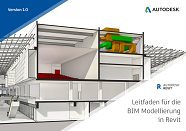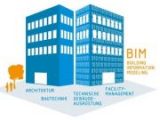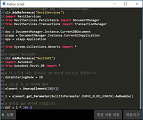Posts By Arcnovumpress
26. LOIN kills LoD
Was ist LOIN?
Die DIN EN 17412–1 definiert den Begriff Level of Information Need, kurz LOIN und ersetzt somit das bestehende Konzept des Entwicklungsgrades LOD („Level of Development“).
25. IDS for Open BIM
Information Delivery Specifications (IDS)
An Information Delivery Specification (IDS) is a computer interpretable document that defines the Exchange Requirements of model based exchange.
It defines how objects, classifications, materials, properties, and even values need to be delivered and exchanged. This is often done based on Industry Foundation Classes (IFC) and additional classifications, materials and properties (national agreements or company specific ones; either stored in bSDD or somewhere else).
This is the standard to use to define your Level of Information Needs (CEN term), your Exchange Information Requirements (ISO 19650 term) or even to exchange Product Data Templates with some more details.
IDS brings validation of IFC to the client, the modeller and the software tools that perform (automated) analyses. It is a core component that can be used as a contract to deliver the correct information („Model as a legal document“). It holds the ability to create localised and use-case specific requirements for your projects and asset portfolio.
The IDS standard is the solution for predictable and reliable data exchange workflows.

24. increíble at last we win
*
Re: Sort project parameters like family parameters – Status changed to: Accepted
Hallo ARCNOVUM.
kimberly.fuhrman (Employee) hat eine neue Kommentar im Board Revit Ideas am 04-05-2022 09:21 AM gesendet:
Congrats! We think this is a great idea, so we’ve decided to add it to our Revit Public Roadmap. Thanks for the suggestion!
The Factory
23. BIM Modellierungsrichtlinie V. 1.0
 AUTODESK BIM BLOG: In einem BIM Projekt zu arbeiten bedeutet viel mehr, als eine Software wie Revit mit allen Funktionen zu beherrschen, sondern auch praxisnahe Arbeitsweisen, Projektentscheidungen und weiterführende BIM Prozesse zu berücksichtigen. Aus diesem Grund sind immer mehr Kunden auf uns zugekommen und haben nach Orientierungshilfen gefragt bzw. nach einem Leitfaden für den effizienten Einsatz von Revit und für weitere BIM Prozesse wie z.B. die Zusammenarbeit mit anderen Disziplinen und Planungsbeteiligten.
AUTODESK BIM BLOG: In einem BIM Projekt zu arbeiten bedeutet viel mehr, als eine Software wie Revit mit allen Funktionen zu beherrschen, sondern auch praxisnahe Arbeitsweisen, Projektentscheidungen und weiterführende BIM Prozesse zu berücksichtigen. Aus diesem Grund sind immer mehr Kunden auf uns zugekommen und haben nach Orientierungshilfen gefragt bzw. nach einem Leitfaden für den effizienten Einsatz von Revit und für weitere BIM Prozesse wie z.B. die Zusammenarbeit mit anderen Disziplinen und Planungsbeteiligten.
22. BIM Guidelines from VDI
 (11.2.2021) Die neue VDI 2552 Blatt 10 unterstützt Planer bei der BIM-gerechten Erstellung von Auftraggeber-Informations-Anforderungen (AIA) und der Konzeption der damit verbundenen Inhalte. Analog dazu enthält die Richtlinie Informationen zu den Zielen und Prinzipien eines BIM-Abwicklungsplans (BAP), zu dessen Inhalten, seiner Struktur und Methodik.
(11.2.2021) Die neue VDI 2552 Blatt 10 unterstützt Planer bei der BIM-gerechten Erstellung von Auftraggeber-Informations-Anforderungen (AIA) und der Konzeption der damit verbundenen Inhalte. Analog dazu enthält die Richtlinie Informationen zu den Zielen und Prinzipien eines BIM-Abwicklungsplans (BAP), zu dessen Inhalten, seiner Struktur und Methodik.
Qualifizierte fachliche Entscheidungen im Rahmen von BIM-Projekten sind nur auf Basis qualitätsgesicherter Informationen möglich. Doch welche Daten für welchen BIM-Prozess zu welchem Zeitpunkt erforderlich sind, ist für die Projektbeteiligten nicht immer ersichtlich. Für den BIM-Profi sind Umfang und Tiefe des tatsächlichen Informationsbedarfs jedoch unverzichtbare Arbeitsgrundlagen.
Zur Erinnerung: AIA und BAP
Zur Rolle des Auftraggebers im BIM-Projekt gehört die Definition der Informationen bzw. Inhalte, die er für seine Zwecke aus dem digitalen Zwilling abgreifen möchte. Dies sind die „Auftraggeber-Informations-Anforderungen“ (AIA). Die AIA sollten die benötigte Informationsfülle und die Informationstiefe möglichst genau beschreiben. Für ihre Erstellung definiert die VDI 2552 Blatt 10 verlässliche Regeln.
Im engen Zusammenhang zur AIA steht der BIM-Abwicklungsplan (BAP). Er bildet die Grundlage für die Informationserstellung, ohne ihn ist die Realisierung von BIM-Projekten praktisch nicht möglich. Auch Hinweise zu Erstellung des BAP sind Gegenstand der VDI 2552 Blatt 10.
Gemeinsamer Kontext
Die Richtlinie setzt AIA und BAP in einen gemeinsamen Kontext und beschreibt deren Rollen und Verknüpfungen bei Ausschreibungen, Angeboten, Eignungsnachweisen und -anforderungen. Sie wendet sich an Bauherren, Planungs- und Baubeteiligte sowie Verantwortliche in Betrieb und Instandhaltung, die die Vorteile der BIM-Methode nutzen möchten ( s.a. baulinks )
21. LOOKUP
POSTED ON SEPTEMBER 24, 2018 BY JAY MERLAN (http://revitaddons.blogspot.com/)
Let’s talk about Revit Lookup, the interactive Revit BIM tool that allows you to explore your data. If you’ve ever had a conversation with me about BIM, you understand that I put most of my efforts towards data within my Revit models. Yes, Revit can produce clean drawings and beautiful renderings, but data within our models is what sets us apart from our predecessors. Revit Lookup is one of the most powerful Revit add-ins for reviewing said data, giving its users the capability to view most of the raw database including several data points that are typically not visible from the frontend. In the screenshot below, you can see that Revit Lookup exposes element data such as element ID, the BoundingBox (x, y, z coordinates), the level ID, and location. All of which are available through the Revit API, but otherwise invisible to the end users. See also nice video from Belinda Carr / 24.01.2020 here : video



